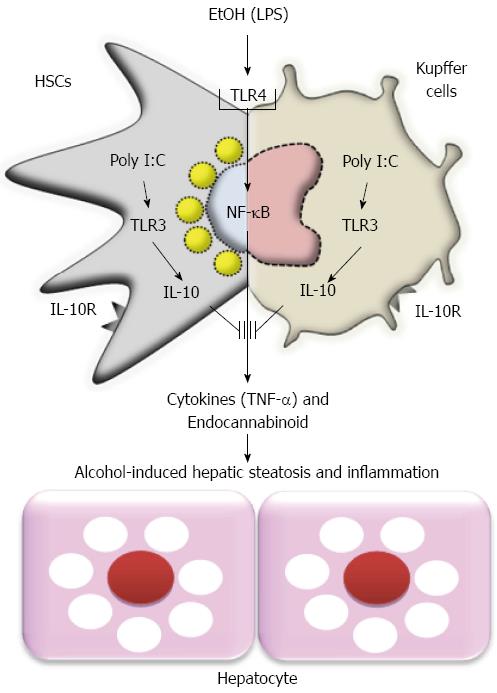Copyright
©The Author(s) 2016.
World J Gastroenterol. Jan 28, 2016; 22(4): 1348-1356
Published online Jan 28, 2016. doi: 10.3748/wjg.v22.i4.1348
Published online Jan 28, 2016. doi: 10.3748/wjg.v22.i4.1348
Figure 1 Chronic ethanol consumption increases CYP2E1 expression in hepatocytes and apoptosis of activated hepatic stellate cells.
Mice were fed with 5% liquid ethanol (EtOH) or isocaloric control (Pair-fed) diet for 8 wk. A: Liver tissues were stained with antibodies of CYP2E1 and α-smooth muscle actin (α-SMA). Hepatic stellate cells (HSCs) were freshly isolated from pair-fed and ethanol-fed mice; B: Liver tissues were stained with TUNEL and apoptotic bodies of non-parenchymal cells were counted. PT: Portal triad; N: Nucleus of hepatocyte. aP < 0.05 in comparison with the corresponding control.
Figure 2 Freshly isolated hepatic stellate cells from liquid ethanol-fed mice were susceptible to natural killer cell killing.
A: Mice were fed with 5% liquid ethanol diet for 8 wk. Hepatic stellate cells (HSCs) were freshly isolated from ethanol-fed mice and then co-cultured with natural killer (NK) cells. NK cells were stained with NKG2D antibody and HSCs were stained with RAE1; B: Schematic overview of NKT cell cytotoxicity against activated HSCs via interferon (IFN)-γ-dependent manner.
Figure 3 Model of ethanol-mediated hepatic steatosis and inflammation and preventive effects of toll-like receptor 3 activation in hepatic stellate cells and Kupffer cells against alcoholic liver injury.
HSCs: Hepatic stellate cells; EtOH: Ethanol; TLR3: Toll-like receptor 3; IL: Interleukin; LPS: Lipopolysaccharide; TNF-α: Tumor necrosis factor α; NF-κB: Nuclear factor kappa B.
- Citation: Seo W, Jeong WI. Hepatic non-parenchymal cells: Master regulators of alcoholic liver disease? World J Gastroenterol 2016; 22(4): 1348-1356
- URL: https://www.wjgnet.com/1007-9327/full/v22/i4/1348.htm
- DOI: https://dx.doi.org/10.3748/wjg.v22.i4.1348











